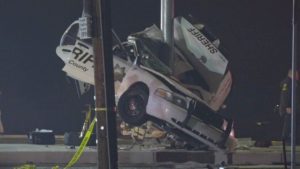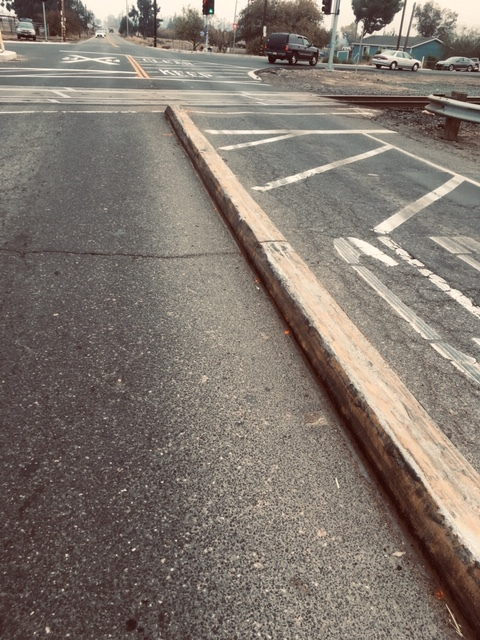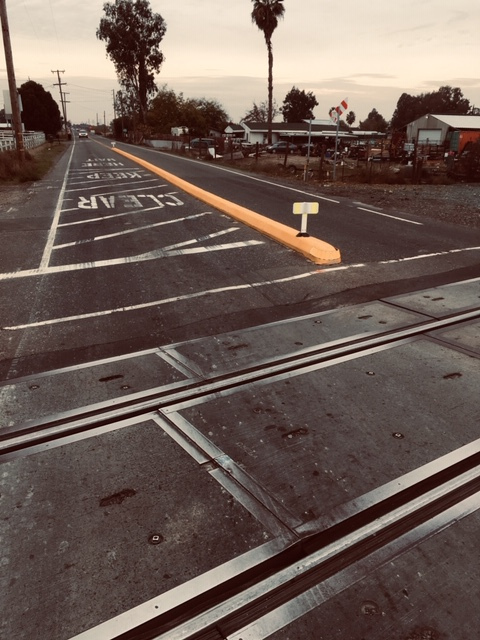Retired attorney and investigative journalist Steve Ringhoff pursues the stories he believes the people need to know. Read more of his fine work here.

–Deputy Sheriff Antonio Hinostroza’s case is rare, because his death was the first vehicle pursuit related death of a Stanislaus County Sheriff’s Deputy; and, even more rare because only about 1 percent of law enforcement officers are killed in those crashes which result in deaths each year.
–The loss of life is especially tragic because we may find that his death was caused by a flaw in the design and/or maintenance of the intersection, aside and apart from the speed involved, which was solely his own decision.
Five other deputies and a community service officer employed by the Sheriff’s office have died in the past 50 years, all but two of those by gunfire. The other two died in a crash which was not related to a pursuit. More detail on these deaths and officers from other agencies, appears later in this piece.
November 25 was a Saturday night. The Riverbank Police and Stanislaus County Deputies acting under a contract to provide police services to that city, got a call about 10 p.m. of a man apparently passed out in a vehicle at Oakdale Road and Patterson. As two officers approached, the man awakened and took off in his Cadillac Escalade.
He led them on a chase east then south, ending in a subdivision in Village One in Modesto where his vehicle, disabled by a spike strip, came to a stop. He resisted but was captured.
At some point, when and where not yet publicly known, Deputy Hinostroza decided to assist. This took him to Claribel Road, going east, lights flashing and siren wailing, according to witnesses. His speed as he approached the intersection of Claribel and Terminal has not been revealed. The Ford Crown Victoria sedan is equipped with an event data recorder (the automotive black box) so it will be known.

What awaited him just before the intersection was a device once necessary, but not maintained. It was an about 8-inch high and about 8 inch wide concrete lane divider. It separated the east and west bound lanes of Claribel west of the intersection, ending at its east end just before the railroad tracks which parallel Terminal through the intersection.
It was painted the same color as the center striping on the roadway. When built, and for a time, the divider was topped with a series of delineators—3-foot high plastic posts. Those posts had been scraped off over time and not replaced. Two days after the crash there was not a single post along that stretch of divider.
At night, and at speed, it would have been hard to distinguish the divider from the center striping. Seeing it there was important. It is about 8 inches tall and the minimum ground clearance, the lowest part of the Crown Vic is 6 inches from the roadway.
Note: The photographs published in The Modesto Bee on December 9 on pages A-1 and 10A depict the intersection and the divider AFTER someone had spruced it up. The divider had been repainted and reflectors and reflective signs installed after the crash and before The Bee’s photos were taken. The Bee’s story and captions did not mention the changes. See our before and after comparison.
The CHP has acknowledged that Deputy Hinostroza’s sedan hit the divider. They have not detailed the effects of that collision. However, visible on the road are gouges, scrapes and tire marks which seem to show that one or more left side tires was over the divider. The path of those marks lead to the light pole into which the sedan collided.
If one or more wheels were over the divider, Deputy Hinostroza would have not been able to control the vehicle. At least one set of witnesses have told the media that the sedan went out of control after hitting what they described as the “center divider.”
Alternatively, one or more of this left side tires could have impacted the divider, remaining on the right side of the divider, but de-beaded by striking the sidewall against the almost perpendicular side of the divider. (A de-bead is a form of blow out where the tire is separated from the rim, causing a full loss of air pressure).
Or, both could have occurred. The marks on the roadway are consistent with a deflated tire and rim.

In any event, the patrol sedan slid into the concrete island upon which the light pole stands. The sedan was rotated clockwise when its wheels hit the island and the car impacted at the top of the A-pillar, driver’s side, killing the deputy on impact.
The divider was apparently constructed when the intersection was controlled by four way stop signs. When a train approached, cars stacked up. Impatient drivers sometimes passed onto the westbound lane to go around.
Finally in late 2015, about 8 years after a train/van collision took 6 lives at the intersection, improvements were made. The collision occurred because cars had stacked up behind the stop sign and the van driver was in the queue exposed to the oncoming Amtrak passenger train going nearly 80 mph.
Traffic signals were installed, along with the concrete island to channelize traffic.
Once the intersection was signalized, there was no need for the barrier. Failing to retain the posts or otherwise warn of its existence to vehicles which could pass through the intersection at speed, presented a danger.
A foreseeable side effect of signalization, of course, is an increase in the number and severity of accidents. Four way stop intersections have all four legs coming to a stop, then proceeding from the stop. Signalized intersections have two opposing legs at speed while two are stopped. Mistakes are at speed.
The increase in accidents noted in The Bee’s December 9 story, shows they increased in 2016, the year the signals were in play, both in number and severity.
Once the signals were installed, there was no need for the divider and it could have been removed.
It usually takes up to a year before the CHP releases its findings and that agency often releases its conclusions without providing the raw data on which it is based. For example, the event data recorder in the sheriff’s sedan not only should provide speed, it should also detail steering wheel movement, throttle and brake application, and even, possibly, an impact before the final impact with the pole, if the sedan struck the center divider with sufficient force.
In this case, Deputy Hinostroza was not in close pursuit of the Escalade. He was on his way to assist those in contact with the fleeing car and driver. He set his own speed, rather than matching the speed of the car being chased.
The Sheriff’s Office has a written policy regarding pursuits but leaves discretion with regard to how a pursuit is conducted up to the individual deputy. The policy does state that no deputy will be criticized or disciplined for terminating a pursuit.
In about 25 percent of their chases, Deputies “aborted” pursuits, according to a review of the 27 chases the department reported to the CHP headquarters for the calendar year 2017.
The Sheriff’s Office is involved directly in about 30 pursuits per year, based on a study of the calendar years 2014, 2015, 2016 and 2017. Again, these figures are compiled from reports the department is required to file with the CHP after every chase.
The speeds reached varied from a crawl (15 mph) to well over 100 (one at 114 mph) in 2017. Speeds of 100 or more were not uncommon, averaging about 11 percent in the four year stretch. Speeds over 90 averaged about 22 percent. Forty percent of the chases saw speeds over 70 mph. All but a few of the chases occurred on streets, not freeways.
According to records kept by a memorial website, only four local law enforcement officers (not including CHP) have died in pursuit type crashes, going back to 1935 when a Turlock motorcycle officer, Lavon New was killed. Modesto Police Officer Leo Volk Jr. died in 1973 while chasing a suspect after swerving to avoid an uninvolved car. Modesto Police Officer Steven May died 1n 2009, seven years after a collision with a suspect’s vehicle while left him in the coma from which he never recovered.
A study by the US Department of Justice covering the years 1996 to 2015 showed an average of 335 persons were killed every year in police chases, The vast majority of deaths are of those fleeing but a substantial number involve bystanders. Only about 1 percent of the deaths are the result of law officers in pursuit, hence the very rare tragedy of the death of Deputy Hinostroza.

“The loss of life is especially tragic because we may find that his death was caused by a flaw in the design and/or maintenance of the intersection, aside and apart from the speed involved, which was solely his own decision.”
Tragic indeed; yet we must wonder both at the apparent speed involved (given the extent of vehicle damage), and the direction of travel. Was the deputy not traveling away from the area of the actual pursuit? Would it have been reasonable to have planned a turn onto Terminal at speed?
I am sorry this death happened and sadden that it might not have happened if the road was properly engineered. Another intersection that is poorly engineered is at Santa Fe and Hatch roads. At night it is poorly lit and there is obstruction in middle of Hatch road. at the railroad tracks. I know because I came close to hitting it one dark night in November.